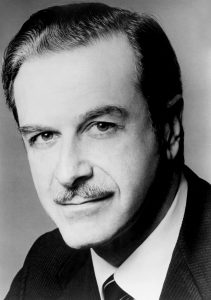
Peter Mennin was a symphonist: of his 26 works, 9 were symphonies.
(Let’s get this “the curse of the 9-thing” out of the way here and now. Mennin completed his Ninth Symphony in 1981, at the age of 58. In 1982, he was diagnosed with pancreatic cancer. He died on June 17, 1983, one month after his 60th birthday. What is it about completing a numbered Ninth Symphony that spells doom for so many composers? Beethoven, Ludwig Spohr, Antonin Dvořák, Anton Bruckner, Gustav Mahler, Alexander Glazunov, Ralph Vaughan Williams, Kurt Atterburg, Elie Siegmeister, Alfred Schnittke, Roger Sessions, Egon Wellesz, Malcolm Arnold, and David Maslanka would all like to have known. Perhaps they would have stopped at eight. Bad for posterity but good for them.)
According to Arnold Schoenberg, who was himself something of a numbers freak and suffered from “Triskaidekaphobia”, the fear of the number 13:
“It seems that the Ninth is a limit. He who wants to go beyond it must pass away. It seems as if something might be imparted to us in the Tenth which we ought not yet to know, for which we are not ready. Those who have written a Ninth stood too close to the hereafter.”
(For our information: Franz Schubert is not on the list above because his so-called “Symphony No. 9 in C Major, “The Great”, is listed in the most recent edition of the Deutsch catalog – compiled by Otto Erich Deutsch – as being “No. 8.” Alexander Glazunov is on the list despite the fact that he only completed the first movement of his ninth symphony.)
Peter Mennini was born on May 17, 1923 in Erie, Pennsylvania, the son of Italian immigrants. (The young Peter changed his name to “Mennin” in order to distinguish himself from his brother Louis – 1920-2000 – who was also a professional composer.) Something of a musical prodigy, he began composing his first work for orchestra when he was 11 and completed his first symphony at 18. At the age of 16 he entered the Oberlin Conservatory of Music. He left two years later (in 1941) to serve in the U.S. Army Air Forces (the precursor to the U.S. Air Force). After two years of service he entered the Eastman School of Music, where he studied composition with Howard Hanson. He completed what was his doctoral dissertation – his Symphony No. 3 – on his 23rd birthday: May 17th, 1946. The Symphony was performed by the New York Philharmonic the following year – 1947 – which opened the door to a faculty appointment at the Juilliard School. (The Symphony was also a runner-up for a Pulitzer Prize; talk about getting maximum mileage from a single work!)

Mennin went on to serve as president of the Peabody Conservatory in Baltimore from 1958-1962, and then president of the Juilliard School (where he succeeded William Schuman) from 1962 until his death in 1983. As president of Juilliard, Mennin oversaw the move in 1969 from 130 Claremont Avenue (just north of West 122nd street and a block east of Grant’s Tomb) to its present location at Lincoln Center (on Broadway between West 65th and 66th streets). As president of Juilliard, Mennin created the dance department; the drama department (he hired the actor John Houseman to run it); and instituted the famed Juilliard Master Class Program as well. …Continue reading and see the prescribed work and recording, only on Patreon!
